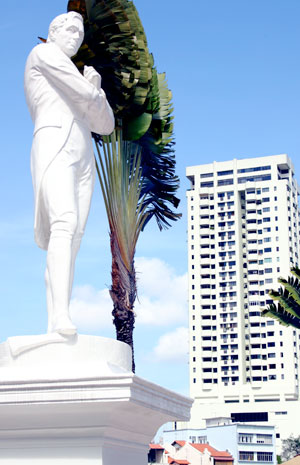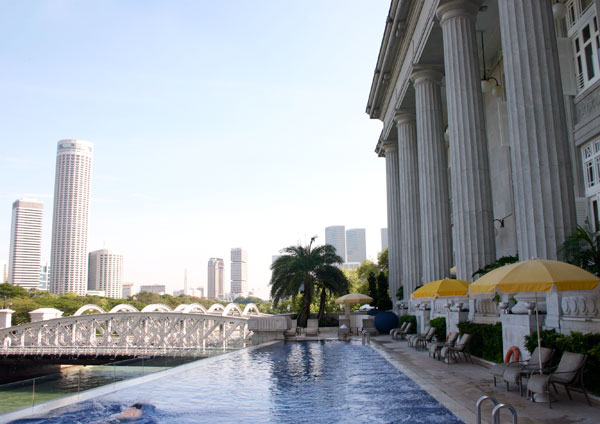SINGAPORE - The white marble statue of Sir Thomas Stamford Raffles stands amid a backdrop of giant buildings and a dark blue sky.
A young woman in a wedding gown asks to have her photograph taken in front of the monument honouring the Englishman who laid the foundation in 1819 for what was to grow into the economic giant of Asia.
“The man (Raffles) is a hero to Singaporeans,” said a taxi driver named Singh, whom I met at a local restaurant where he introduced me to a neighborhood treat called kaya toast – a delicious sweet spread made of egg, coconut and sugar. It wasn’t the only sweet treat Singh would introduce me to during a two-day tour of this city/country where three Asian cultures meet and prosper in neighborhoods that have become the focal point for tourists.
“Raffles was a visionary who, thanks to his orderly concept, made our country a model for the world – where everything works like a Swiss clock,” said Singh, who makes his home in Singapore’s vibrant 12-block Indian district around colorful Serangoon Road.
In his grand plan for the city, which was first settled by Chinese sailors, Raffles divided it into ethnic enclaves where the majority Chinese share space with the Indian and Malay populations. While each has their own distinct community, each offers something unique and interesting for tourists to witness.
“Everyone is treated equally in Singapore, no matter what community you belong to. We all learn to get along while completing our (compulsory) military service,” said Singh while we enjoyed a coffee at a Kopihiam (kopi is the Chinese word meaning coffee and hiam means shop) on Killiney Road, a handsome street featuring deep covered sidewalks; leftovers from the city’s colonial British past.
Singapore is really a city of villages. There’s Chinatown, Little India and Arab Town, made up of Muslims who came from Malaysia, a causeway away. Each community offers its own unique style and leaves tourists with the feeling they’ve actually seen three countries in one visit.
In his grand plan for Singapore, Raffles wanted to make this the most beautiful city in Asia and succeeded by incorporating a series of grand parks in his blueprint. That’s earned Singapore the nickname “Garden City”.


Left: Sir Thomas Ramford Raffles is still revered in Singapore. Right: The old post office now a hotel.
“After we finish our coffees, I will take you to Arab Town,” said Singh, referring to an area of the city where Muslims sell tasty treats like satas from roadside stands and where the skyline is dominated by mosque domes.
Singh dropped me off on Arab Street and told me to wander the area but cautioned: “Don’t be conned into paying too much for the carpets.”
It’s hard to resist the handmade creations being offered in the shops that make up Arab Town, especially the hand-woven masterpieces that sell here for a fraction of the price charged elsewhere. There’s a fairly large pedestrian mall leading to the main mosque, where people kneel on the sidewalk pointing to Mecca and pray.
About an hour later, Singh returned and I asked him to open the boot (trunk) so I could store my small carpet. “I knew it was dangerous leaving you here alone,” said Singh with a sly smile.
As we made our way to Chinatown, Singh told me Singapore’s population breaks down to 77 per cent Chinese, 14 per cent Malay, 7 per cent Indian and 2 per cent Eurasians and the rest are known as Perenakans, a mix race of Chinese and Malay. The dominate languages here are Chinese, Tamil, Malaysian and English, which is still compulsory in Singapore’s schools. The Chinese community around Eu Tong Sang Street is set amidst a cluster of brightly painted buildings with flowers etched on them. The area looks like it’s a leftover from the hippie era.
Chinatown is made up of mostly shops and restaurants, where you can sample traditional dishes like spicy crab, a delicacy that’s served swimming in an atomic dark sauce that explodes in your mouth. Busy Sim Lim Square is where you will find a 24-hour department store that sells everything from computers to combs.
In recent years, Singapore’s traditional eateries have faced stiff competition from invading fast food restaurants. McDonalds alone has 125 outlets in this compact city of four million and is one of the highest employers – 6,000. But with 3,600 restaurants in total, there are still plenty of places left to sample local delicacies. After all, Singaporeans will tell you their favorite pastime is eating.
After a good night’s sleep at the Fullerton Hotel, the country’s former post office and now one of its top 5-star properties, Singh picked me up early for a tour of Little India.
The real India is just a short plane ride away so many people from Delhi and Mumbai come here to shop. This district was actually created after one of the few minor conflicts Raffles faced during his planning of Singapore. The Indian population were granted space near the city’s port but quietly rebelled and moved to this district so they could raise their cattle. The only cows you’ll see along Serangoon Road, the main thoroughfare in Little India, are the ones carved into the temples that line this route.
Serangoon Road is busy most days with women in colorful saris scurrying about the outdoor market buying spices and vegetables for their dinner tables. The day Singh took me to his home district, the streets were crowded with people getting ready for Deepavali, the Hindu festival of lights. Serangoon Road was decorated with banners and lights and local temples were full with worshippers.
The temples are the main attraction in Little India. Their pyramid roofs are decked out with intricate carvings that number in the hundreds. The handsome Sri Veeramakaliamman Temple was built in 1885 and is the city’s oldest.
“Do you mind if I take time to visit the temple?” asked Singh, who removed his shoes before entering the beautiful building with the golden interior.
Singapore is one of the busiest cities in the world, with 23 million people passing through delightful Chiang International Airport each year and 320 ships docking here each day. It’s also the richest community in Asia, which is reflected in the number of designer stores and fast foreign cars you see here.
But hey, if you’ve got it, why not flaunt it!
A short drive from the downtown core is the wonderful Jurong Bird Park, where many colorful species flourish and entertain visitors. The park offers breakfast with the birds which has become very popular with families.
Another excellent gathering spot for families is Sentosa Island, which offers some of the finest beaches, accommodation and spas in the world. Sentosa is a woodlands area where you can stroll amidst tropical splendor or enjoy a pizza by the shallow water’s edge.
There’s something for everyone in Singapore, the one-stop Asia destination.
Information
- The Fullerton Hotel is a deluxe property located on the banks of the Singapore River in the city’s downtown core. Room rates start at about $250 a night. For information, go to http://www.fullertonhotel.com
- Car rentals in Singapore come with a driver but they are costly – about $30 an hour which included the driver.
- The city has an excellent transit system consisting of buses, subway and elevated trains that are very clean, efficient and very cheap. A subway train from downtown to the airport costs about $1.65.
- Restaurants range from fast food to luxury in Singapore, which is noted for its night food markets where excellent meals can be purchased for just a few dollars.
About the Author
Marc Atchison is a veteran journalist and a seasoned traveller with more than 20 years of travel writing experience. As the former Travel Editor of the Toronto Star, Canada's largest newspaper, and now Editor-in-Chief and Senior Writer for TraveLife magazine (Canada) and travelife.ca, Marc has been to over 100 countries in the world. Japan is one of his favorite destinations and he's been there on numerous occasions.